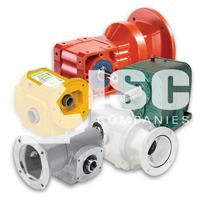 Gears / Gearboxes
Gears / Gearboxes
ISC Companies and affiliate Adams-ISC are distributors of mechanical power transmission parts including open and enclosed gears (gearboxes). For more information about the brands we offer and/or pricing, please contact us by phone 763-559-0033, by email [email protected], or by filling out our online contact form.
A gear, or cogwheel, is a rotating machine part that has teeth that mesh with another toothed part to transmit torque. Geared devices can change the speed, torque, and direction of a power source. Gears almost always produce a change in torque through their gear ratio. The teeth on the two meshing gears are the same shape.
Two or more meshing gears, working in a sequence, are called a gear train or a transmission. A gear can mesh with a non-rotating toothed part, called a rack, changing the position of an object instead of rotation. The gears in a transmission are analogous to the wheels in a pulley system. An advantage is that the teeth prevent slipping.
Gears can be mounted on shafts, and their center lines can be parallel or at any angle relative to each other and in one or more planes. They are supplied either unassembled (open) or assembled as part of an enclosed gearbox or speed reducer.
Backlash
Backlash is the amount of play between the meshing teeth of two mating gears. A small amount must be built into the drive to allow the gears to perform properly, and the required amount depends on the application. Backlash provides clearance for proper lubrication and prevents binding. It also compensates for conflicting tolerances, misalignment, and thermal expansion.
Specifications
When ordering, the diametral pitch, tooth size, pitch diameter, size, pressure angle, tooth shape, and shaft size should be specified. It should also be determined if they need to be metric. Diametral pitch is the ratio of the pitch diameter in inches to the number of teeth. Two gears will not engage properly unless the diametral pitch and pressure angle are the same for both.
Tooth Failures
Tooth failures generally fall into one of the following categories: wear, surface fatigue (pitting), plastic flow, breakage, and process-related failures.
Top Brands We Offer
 Content on this page was created using excerpts from the Power Transmission Handbook (5th Edition), which is written and sold by the Power Transmission Distributor’s Association (PTDA).
Content on this page was created using excerpts from the Power Transmission Handbook (5th Edition), which is written and sold by the Power Transmission Distributor’s Association (PTDA).






















You must be logged in to post a comment.